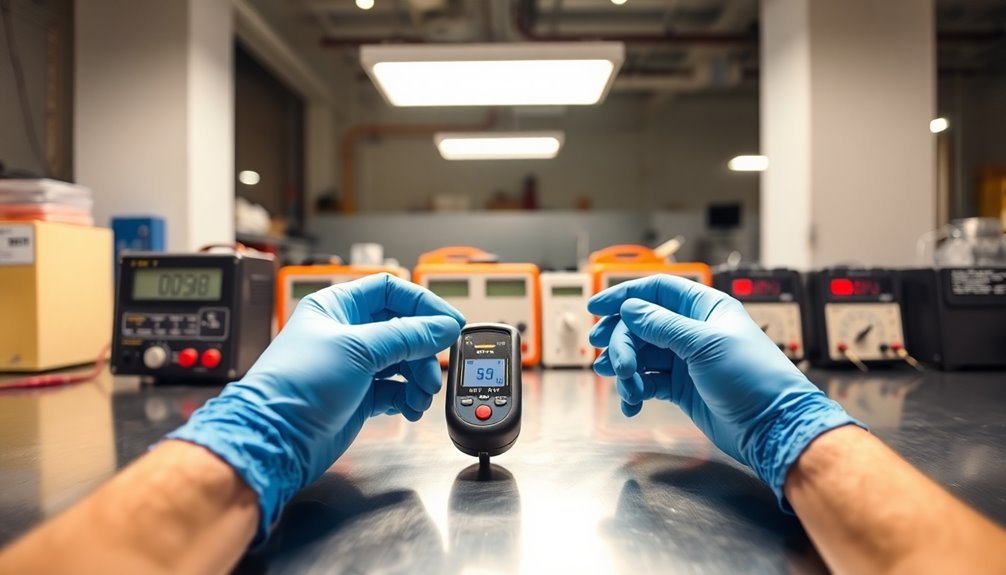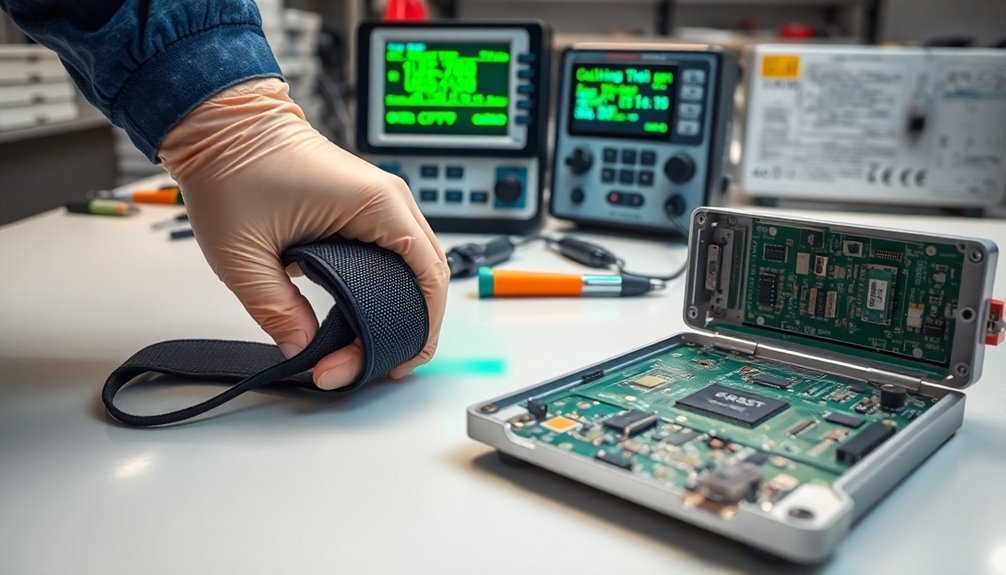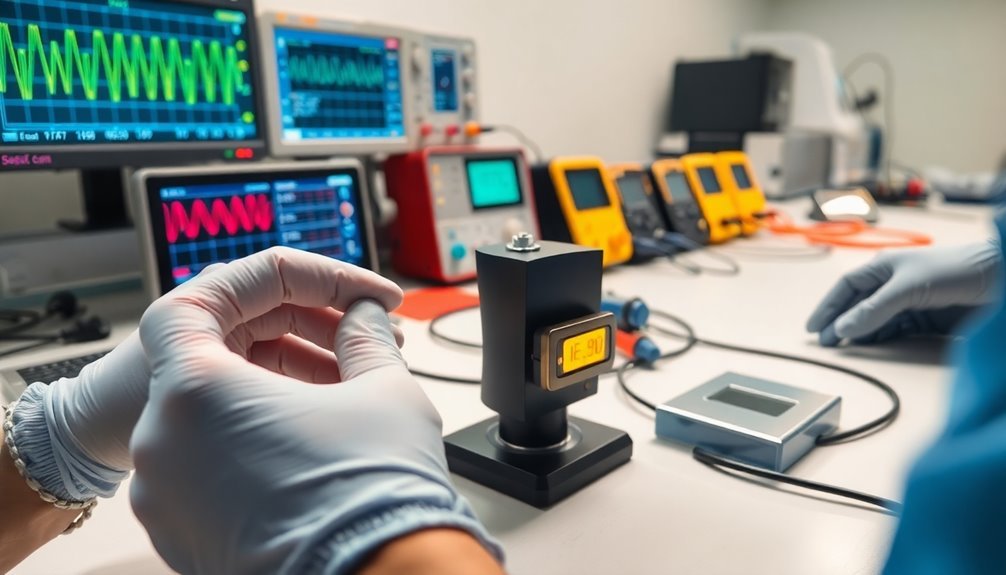Train your team effectively on ESD monitoring equipment by focusing on five key areas. Start with teaching ESD monitoring basics like proper mat and wrist strap verification. Next, establish clear equipment calibration procedures following manufacturer guidelines. Make certain staff can quickly identify common equipment failures through hands-on practice with simulators and testing devices. Implement systematic data collection methods using measurement tools like field meters and resistance meters. Finally, develop robust documentation practices for tracking calibration, testing, and maintenance activities. Following these tips will help you build a thorough ESD control program that protects sensitive electronics and guarantees compliance.
Understanding ESD Monitoring Basics

When you're setting up your workstation, you must verify that your ESD mats and wrist straps are correctly installed and maintained.
If you're using continuous monitoring systems, you won't need to perform daily wrist strap testing, but you'll still need to measure Resistance to Ground separately.
Remember that continuous monitors verify the connections to your worksurface, not the surface itself.
All workstations require a common point ground to ensure equipment and personnel maintain the same electrical potential.
Understanding these basics will help you identify and implement the right procedures for your ESD control needs.
Equipment Calibration Best Practices
Proper calibration of ESD monitoring equipment forms the foundation of reliable static control programs. You'll need to establish clear calibration intervals based on manufacturer guidelines and your specific ESD testing requirements.
Always use traceable calibration standards to guarantee your measurements link to nationally recognized benchmarks.
Make certain you're maintaining detailed calibration logs that document all outcomes and adjustments. You'll want to keep your calibration environment consistent and your equipment well-maintained through regular cleaning and functional testing. Environmental factors like temperature and humidity must be carefully monitored as they can significantly impact calibration accuracy.
Don't forget to follow established industry procedures and consider using accredited calibration services.
If you're handling calibrations in-house, you'll need to properly train your personnel. Ascertain they understand calibration procedures, equipment operation, and compliance requirements.
Your team should know how to maintain accurate documentation and follow proper record-keeping practices.
Set up a schedule for periodic verification testing based on your product value and potential ESD failure risks. You'll want to implement system tests and continuous monitoring, with verification checks performed semi-annually.
Remember to test your worksurfaces regularly and follow the guidelines outlined in the ESD Handbook TR 20.20 for all verification procedures.
Common Monitoring Equipment Failures

Identifying monitoring equipment failures quickly can prevent costly disruptions to your ESD control program. You'll need to master several identification techniques, including ESD current path tracing with an oscilloscope and H-field probe, and systematic failure reproduction to pinpoint root causes.
When troubleshooting, you'll commonly encounter failures due to inadequate grounding, where floating metal parts on enclosures create vulnerability points. Poor mechanical construction and insufficient noise filtering can also compromise your monitoring system's effectiveness. Voltage levels during testing typically range from 4 kV to 15 kV for commercial products.
Don't overlook the importance of proper material selection and environmental controls like humidity management.
You'll need specific tools to diagnose these issues effectively. Use ESD simulators to inject low-voltage pulses at suspected failure points, and employ H-field probes with your oscilloscope to trace current paths. High-performance oscilloscopes and specialized current tracer probes like the HP 457A will help you analyze ESD events in detail.
Make certain you're following established standards like ANSI/ESD S20.20 and maintaining thorough training programs. Regular audits will help you verify your ESD control program's effectiveness and identify areas needing improvement.
When issues arise, follow clear failure analysis procedures to guarantee consistent problem resolution.
Practical Hands-On Testing Methods
Building on your knowledge of monitoring equipment failures, mastering practical hands-on testing methods will strengthen your ESD control program.
You'll need to follow standard compliance procedures while setting up your ESD simulator and discharge network properly. When conducting tests, apply controlled ESD events to your device under test (DUT) while monitoring its performance for any malfunctions. Following ISO 10605 standards is particularly crucial when testing automotive electronic components.
Set up dedicated practice workstations where your team can gain hands-on experience with ESD-safe equipment. You'll want to incorporate real-life demonstrations showing both correct and incorrect handling techniques to emphasize the impact of proper ESD safety measures.
- Use continuous monitoring instruments to verify the integrity of surfaces and workwear
- Conduct regular compliance verification audits using specialized test equipment
- Implement detailed checklists to maintain consistency in your testing procedures
- Create trend charts to track effectiveness and trigger necessary process adjustments
- Practice with ESD wrist straps, mats, and anti-static bags in training sessions
Remember to document all test results and maintain detailed records of your ESD testing procedures.
If your DUT fails any tests, implement design changes or mitigation techniques promptly to guarantee ongoing protection of sensitive components.
Data Collection and Analysis

Effective data collection and analysis form the backbone of any robust ESD monitoring program. You'll need to master various measurement tools, including electrostatic field meters, surface resistance meters, and continuous monitoring systems to gather thorough data about your facility's ESD conditions.
Start by implementing a systematic approach to data collection. Use data acquisition systems to simultaneously monitor multiple locations, and verify you're logging all measurements with accurate time and date stamps. You'll want to compare your readings against established ESD control standards to identify any areas that need attention.
When analyzing your data, focus on identifying trends and patterns that might indicate potential ESD vulnerabilities. Use high-speed storage oscilloscopes and specialized antennae to classify ESD events properly. Consider that ESD damage thresholds for modern semiconductor devices can be as low as 100V CDM, making precise measurement critical.
Don't forget to integrate your findings with ESD management software for seamless tracking and analysis. Set up real-time alerts for excessive charge events so you can take immediate corrective action.
Store all your data in a centralized repository and generate regular trend charts and detailed records. This documentation won't just help you maintain compliance – it'll also provide valuable insights for continuous improvement of your ESD control program.
Frequently Asked Questions
How Often Should ESD Monitoring Equipment Be Replaced Even if Working Properly?
You should replace your ESD monitoring equipment every 6-12 months, following manufacturer's guidelines, even if it's working properly. Don't wait for failure, as preventive replacement guarantees continuous protection against static discharge.
Can Temperature and Humidity Affect ESD Monitoring Equipment Accuracy Significantly?
Yes, you'll find that temperature and humidity greatly impact your ESD monitoring equipment's accuracy. High humidity can cause false readings, while temperature changes affect surface resistivity measurements and sensor performance.
What Backup Systems Should Be in Place if Monitoring Equipment Fails?
You'll need dual-wire monitoring systems, backup monitors, spare parts ready for quick replacement, and clear emergency protocols. Don't forget to maintain detailed maintenance records and implement alarm systems for immediate alerts.
Are Wireless ESD Monitoring Systems as Reliable as Wired Ones?
No, you can't rely on wireless ESD monitoring systems like wired ones. They don't meet ANSI/ESD S20.20 standards, can generate dangerous voltage levels, and won't provide the continuous monitoring that's essential for sensitive environments.
How Do Different Brands of ESD Monitoring Equipment Compare in Longevity?
You'll find established brands like Desco and SCS typically offer better longevity due to superior components and support. They're more expensive upfront but last longer than budget alternatives through consistent performance and durability.
In Summary
You'll find ESD monitoring success comes down to consistent training and attention to detail. Remember to verify calibration schedules, troubleshoot equipment regularly, and keep detailed records of your testing data. Don't skip hands-on practice with your monitoring tools, and always stay current with ESD safety protocols. By following these guidelines, you're ensuring both workplace safety and equipment protection while maintaining quality control standards.




Leave a Reply